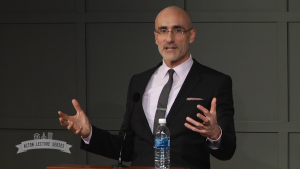


President Trump has designated this week as “Infrastructure Week,” a time dedicated to “addressing America’s crumbling infrastructure.” Here are five facts you should know about America’s infrastructure.
1. The Federal government has defined infrastructure as the framework of interdependent networks and prising identifiable industries, institutions (including people and procedures), and distribution capabilities that provide a reliable flow of products and services essential to the defense and economic security of the United States, the smooth functioning of governments at all levels, and society as a whole.
2. Critical Infrastructures are infrastructures that are so vital that their incapacitation or destruction would have a debilitating impact on defense or economic security. The Presidential Policy Directive on Critical Infrastructure Security identifies sixteen categories of critical infrastructure sectors and the executive agency in charge of maintaining their secure functioning: Chemical sector (Homeland Security (DHS)), Commercial Facilities Sector (DHS), Communications Sector (DHS), Critical Manufacturing Sector (DHS), Dams Sector (DHS), Defense Industrial Base Sector (DoD), Emergency Services Sector (DHS), Energy Sector (Dept. of Energy), Financial Services Sector (Treasury), Food and Agriculture Sector (USDA, HHS), Government Facilities Sector (DHS), Healthcare and Public Health Sector (HHS), Information Technology Sector (DHS), Nuclear Reactors, Materials, and Waste Sector (DHS), Transportation Systems Sector (DHS, Dept. of Transportation), Water and Wastewater Systems Sector (EPA).
3. Every four years, the American Society of Civil Engineers (ASCE) provides prehensive assessment of 16 major infrastructure categories in ASCE’s Infrastructure Report Card. Each category receives a letter grade from A to F. For 2017 the ASCE gave these grades: Aviation (D); Dams (D); Energy (D+); Inland Waterways (D); Ports (C+); Rail (B); Schools (D+); Solid Waste (C+); Bridges (C+); Drinking Water (D); Hazardous Waste (D+); Levees (D); Public Parks (D+); Roads (D); Transit (D-); and Wastewater (D+).
4. According to the Federal Highway Administration, there are currently 4.12 million miles of road in the United States. The core of the nation’s highway system is the 47,575 miles of Interstate Highways, prise just over one percent of highway mileage but carry one-quarter of all highway traffic. The Interstates plus another 179,650 miles of major prise the National Highway System, which carries most of the highway freight and traffic in the U.S. Most of the roads in the U.S., 2.94 million miles, are located in rural areas, with the remaining 1.18 million miles located in urban areas. Of the 4.07 million miles of road, about 2.68 million miles are paved, which includes most roads in urban areas. However, 1.39 million miles or more than one-third of all road miles in the U.S. are still unpaved gravel or dirt roads. These are largely local roads or minor collectors in rural areas of the country. Between 2000 and 2013, the U.S. built an average of 13,788 center-line miles of new roads per year. The U.S. also has 614,387 bridges, almost four in 10 of which are 50 years or older. According to ASCE, almost ten percent of the nation’s bridges were structurally deficient in 2016, and on average there were 188 million trips across a structurally deficient bridge each day.
5. Most funding for the construction of es from the federal Highway Trust Fund, a dedicated, user fee-funded source. The primary funding source for this fund is the federal motor fuels tax. According to the ASCE, the tax of 18.4 cents per gallon for gasoline and 24.4 cents for diesel has not been raised since 1993, and inflation has cut its purchasing power by 40 percent. In 2014, the federal government spent $43.5 billion on capital costs for highway infrastructure (including bridges) and state and local governments spent $48.3 billion. State and local governments are responsible for the operation and maintenance of all highways and roads not located on federal lands.









